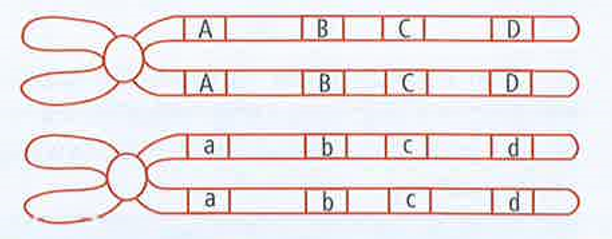Cause of chromosome laggards in meiosis is
Inversion
Dicentric chromosome
Acentric chromosome
Duplication of a gene
The correct Answer is:B
Step-by-Step Solution
1. Understanding Chromosome Laggards:
- Chromosome laggards refer to chromosomes that fail to move to the poles during cell division, particularly during meiosis. This results in unequal distribution of chromosomes to the daughter cells.
2. Identifying the Cause:
- To determine the cause of chromosome laggards, we need to examine the mechanisms of chromosome movement during meiosis. Chromosomes are pulled apart by spindle fibers, which attach to the centromeres.
3. Analyzing the Options:
- A. Inversion: This refers to a chromosomal rearrangement where a segment of a chromosome is reversed end to end. While it can affect gene expression, it does not directly cause lagging chromosomes.
- B. Dicentric Chromosome: This is a chromosome that has two centromeres due to the fusion of two chromatids. The presence of two centromeres can lead to improper attachment to spindle fibers, causing lagging during separation.
- C. Acentric Chromosomes: These chromosomes lack a centromere, which would prevent them from being pulled by spindle fibers, potentially leading to lagging.
- D. Duplication of Gene: This refers to a segment of DNA being duplicated. While it can lead to genetic imbalances, it does not directly cause lagging of chromosomes.
4. Conclusion:
- The most appropriate answer to the question about the cause of chromosome laggards in meiosis is B. Dicentric Chromosome. The presence of two centromeres interferes with the normal separation of chromosomes, leading to lagging.
- Chromosome laggards refer to chromosomes that fail to move to the poles during cell division, particularly during meiosis. This results in unequal distribution of chromosomes to the daughter cells.
- To determine the cause of chromosome laggards, we need to examine the mechanisms of chromosome movement during meiosis. Chromosomes are pulled apart by spindle fibers, which attach to the centromeres.
- A. Inversion: This refers to a chromosomal rearrangement where a segment of a chromosome is reversed end to end. While it can affect gene expression, it does not directly cause lagging chromosomes.
- B. Dicentric Chromosome: This is a chromosome that has two centromeres due to the fusion of two chromatids. The presence of two centromeres can lead to improper attachment to spindle fibers, causing lagging during separation.
- C. Acentric Chromosomes: These chromosomes lack a centromere, which would prevent them from being pulled by spindle fibers, potentially leading to lagging.
- D. Duplication of Gene: This refers to a segment of DNA being duplicated. While it can lead to genetic imbalances, it does not directly cause lagging of chromosomes.
- The most appropriate answer to the question about the cause of chromosome laggards in meiosis is B. Dicentric Chromosome. The presence of two centromeres interferes with the normal separation of chromosomes, leading to lagging.
Topper's Solved these Questions
- CHROMOSOMAL BASIS OF INHERITANCEBOOK - DINESH PUBLICATION ENGLISHCHAPTER - CHROMOSOMAL BASIS OF INHERITANCEEXERCISE - Check Your Grasp
57 Videos
- CHORDATA- PROTOCHORDATABOOK - DINESH PUBLICATION ENGLISHCHAPTER - CHORDATA- PROTOCHORDATAEXERCISE - CYG
11 Videos
- COELENTERATA AND CTENOPHORA (OR CNIDARIA AND ACNIDARIA)BOOK - DINESH PUBLICATION ENGLISHCHAPTER - COELENTERATA AND CTENOPHORA (OR CNIDARIA AND ACNIDARIA)EXERCISE - CYG
10 Videos
Similar Questions
Knowledge Check
Given diagram shows a pair of homologous chromosomes during meiosis

Maximum crossing over will occur between genesAA and a,D and dBC and d, c and DCB and c, b and CDA and d, a and D
Assertion : Replication of DNA not occurs during interkinesis.
Reason : Divison of chromosomes takes place during meiosis-II.
View SolutionWho observed that the behaviour of chromosomes at meiosis can serve as the cellular basis of both segregation and independent assortment?
View SolutionWhich of the following correctly shows a pair of homologous chromosomes at the start of meiosis?
View SolutionDuring meiosis, a microspore mother cell has 12 bivalents, the number of chromosomes in its pollen grains will be:
View SolutionExchange of chromosome segments between maternal and paternal chromatids during meiosis is called.
Or
In meiosis the daughter cells are not similar to that of parent because of
View SolutionThe exchange of chromatid parts between the maternal and paternal chromatids of a pair of homologous chromosomes during meiosis.
View SolutionIf a meiocyte of a diploid organism on G, phase has 20 chromosomes and 40 pg DNA then what will be the number of chromosomes (a) and amount of DNA (b) in each cell after completion of meiosis-I?
View Solution
